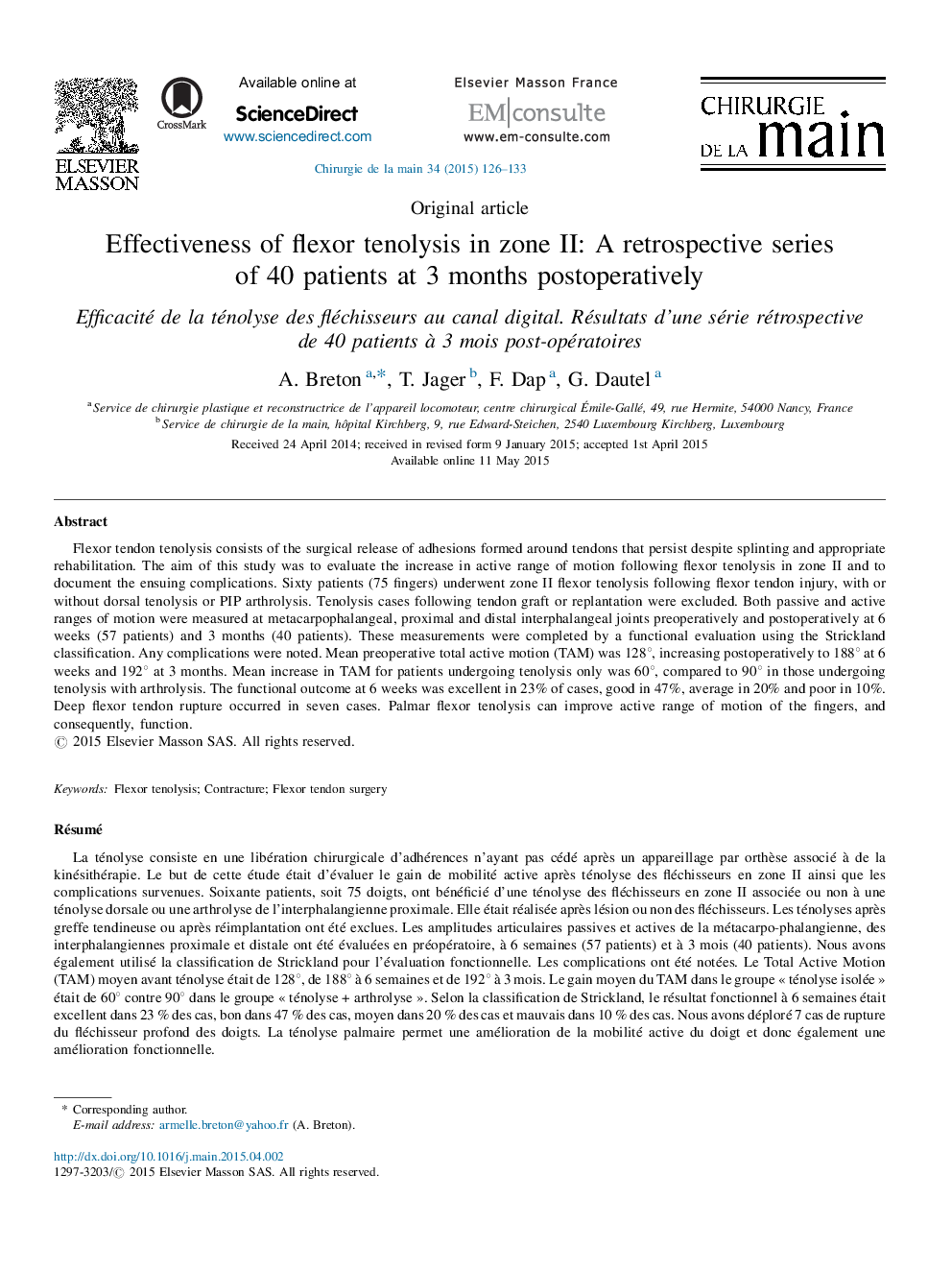| Article ID | Journal | Published Year | Pages | File Type |
|---|---|---|---|---|
| 4048627 | Chirurgie de la Main | 2015 | 8 Pages |
Flexor tendon tenolysis consists of the surgical release of adhesions formed around tendons that persist despite splinting and appropriate rehabilitation. The aim of this study was to evaluate the increase in active range of motion following flexor tenolysis in zone II and to document the ensuing complications. Sixty patients (75 fingers) underwent zone II flexor tenolysis following flexor tendon injury, with or without dorsal tenolysis or PIP arthrolysis. Tenolysis cases following tendon graft or replantation were excluded. Both passive and active ranges of motion were measured at metacarpophalangeal, proximal and distal interphalangeal joints preoperatively and postoperatively at 6 weeks (57 patients) and 3 months (40 patients). These measurements were completed by a functional evaluation using the Strickland classification. Any complications were noted. Mean preoperative total active motion (TAM) was 128°, increasing postoperatively to 188° at 6 weeks and 192° at 3 months. Mean increase in TAM for patients undergoing tenolysis only was 60°, compared to 90° in those undergoing tenolysis with arthrolysis. The functional outcome at 6 weeks was excellent in 23% of cases, good in 47%, average in 20% and poor in 10%. Deep flexor tendon rupture occurred in seven cases. Palmar flexor tenolysis can improve active range of motion of the fingers, and consequently, function.
RésuméLa ténolyse consiste en une libération chirurgicale d’adhérences n’ayant pas cédé après un appareillage par orthèse associé à de la kinésithérapie. Le but de cette étude était d’évaluer le gain de mobilité active après ténolyse des fléchisseurs en zone II ainsi que les complications survenues. Soixante patients, soit 75 doigts, ont bénéficié d’une ténolyse des fléchisseurs en zone II associée ou non à une ténolyse dorsale ou une arthrolyse de l’interphalangienne proximale. Elle était réalisée après lésion ou non des fléchisseurs. Les ténolyses après greffe tendineuse ou après réimplantation ont été exclues. Les amplitudes articulaires passives et actives de la métacarpo-phalangienne, des interphalangiennes proximale et distale ont été évaluées en préopératoire, à 6 semaines (57 patients) et à 3 mois (40 patients). Nous avons également utilisé la classification de Strickland pour l’évaluation fonctionnelle. Les complications ont été notées. Le Total Active Motion (TAM) moyen avant ténolyse était de 128°, de 188° à 6 semaines et de 192° à 3 mois. Le gain moyen du TAM dans le groupe « ténolyse isolée » était de 60° contre 90° dans le groupe « ténolyse + arthrolyse ». Selon la classification de Strickland, le résultat fonctionnel à 6 semaines était excellent dans 23 % des cas, bon dans 47 % des cas, moyen dans 20 % des cas et mauvais dans 10 % des cas. Nous avons déploré 7 cas de rupture du fléchisseur profond des doigts. La ténolyse palmaire permet une amélioration de la mobilité active du doigt et donc également une amélioration fonctionnelle.
